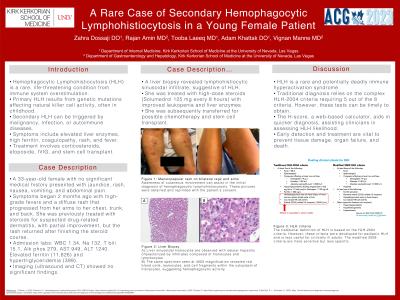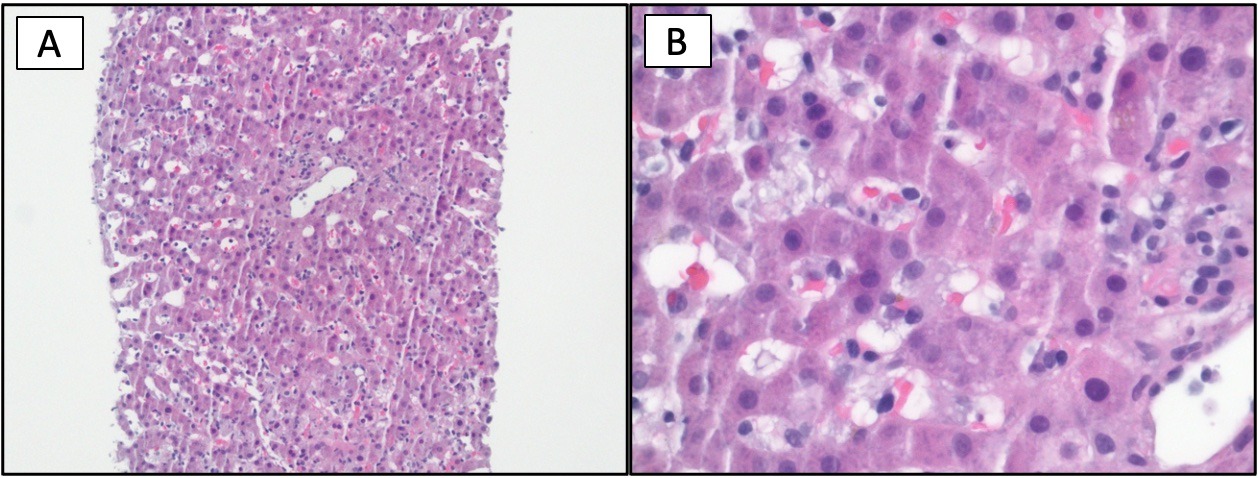Tuesday Poster Session
Category: Liver
P3911 - A Rare Case of Secondary Hemophagocytic Lymphohistiocytosis in a Young Female
Tuesday, October 24, 2023
10:30 AM - 4:00 PM PT
Location: Exhibit Hall

Has Audio

Zahra Dossaji, DO
Kirk Kerkorian School of Medicine at UNLV
Las Vegas, NV
Presenting Author(s)
Zahra Dossaji, DO1, Rajan Amin, MD2, Tooba Laeeq, MD3, Adam Khattak, DO1, Vignan Manne, MD1
1Kirk Kerkorian School of Medicine at UNLV, Las Vegas, NV; 2University of Nevada, Las Vegas, Las Vegas, NV; 3University of Nevada, Las Vegas, Henderson, NV
Introduction: Hemophagocytic lymphohistiocytosis (HLH) is a rare and life-threatening condition that results from the overstimulation of the immune system, leading to systemic inflammation and multi-organ failure. Primary HLH is predominantly caused by genetic mutations that impair the cytotoxic activity of natural killer cells, and presents in infancy and childhood. Secondary HLH can be associated with an inciting cause that results in immune dysregulation, such as malignancy, immunodeficiency, autoimmune disease, or infection. HLH is very rare and can manifest as elevated liver enzymes, hyperferritenemia, coagulopathy, elevated LDH and CRP, rash, hyponatremia, hypertriglyceridemia, and fevers. Treatment involves corticosteroids, IVIG, and stem cell transplant. Here we present a patient with elevated liver enzymes who was found to have HLH diagnosed with liver biopsy.
Case Description/Methods: A 33-year-old female with no significant medical history presented with jaundice, rash, nausea, vomiting, and abdominal pain. She reported that her symptoms started 2 months ago with high-grade fevers and diffuse rash that began on her arms and progressed to her chest, trunk, and back. She was started on steroids 1 month ago due to concern for drug-related dermatitis, and her rash slightly improved, but returned after finishing steroid course. Labs after completion of steroids revealed WBC 2.5, T bili 10.4, D bili 8.07, Alk phos 231, AST 528, and ALT 843. Labs on admission revealed WBC 1.34, Na 132, T bili 15.1, Alk phos 279, AST 949, and ALT 1240. She also had an elevated ferritin of 11,826 and hypertriglyceridemia of 399. An abdominal ultrasound and CT chest/abdomen/pelvis were unremarkable. A liver biopsy revealed mild lobular hepatitis with mixed inflammation and extensive lymphohistiocytic sinusoidal infiltrate, concerning for HLH (Figure 1). She was started on high-dose steroids (Solumedrol 125 mg every 8 hours) with improvement in her pancytopenia and liver enzymes. The patient was transferred to a higher level of care for possible oncology chemotherapy and stem cell transplant.
Discussion: HLH is a rare but potentially fatal syndrome of immune hyperactivation and may be an under-recognized immune-related adverse event. Early diagnosis and treatment of HLH are critical to avoid progressive tissue damage, organ failure, and possible death. Although HLH is a rare disease, it should always be considered in cases with ambiguous clinical presentations associated with elevated liver enzymes, fevers, and inflammation.

Disclosures:
Zahra Dossaji, DO1, Rajan Amin, MD2, Tooba Laeeq, MD3, Adam Khattak, DO1, Vignan Manne, MD1. P3911 - A Rare Case of Secondary Hemophagocytic Lymphohistiocytosis in a Young Female, ACG 2023 Annual Scientific Meeting Abstracts. Vancouver, BC, Canada: American College of Gastroenterology.
1Kirk Kerkorian School of Medicine at UNLV, Las Vegas, NV; 2University of Nevada, Las Vegas, Las Vegas, NV; 3University of Nevada, Las Vegas, Henderson, NV
Introduction: Hemophagocytic lymphohistiocytosis (HLH) is a rare and life-threatening condition that results from the overstimulation of the immune system, leading to systemic inflammation and multi-organ failure. Primary HLH is predominantly caused by genetic mutations that impair the cytotoxic activity of natural killer cells, and presents in infancy and childhood. Secondary HLH can be associated with an inciting cause that results in immune dysregulation, such as malignancy, immunodeficiency, autoimmune disease, or infection. HLH is very rare and can manifest as elevated liver enzymes, hyperferritenemia, coagulopathy, elevated LDH and CRP, rash, hyponatremia, hypertriglyceridemia, and fevers. Treatment involves corticosteroids, IVIG, and stem cell transplant. Here we present a patient with elevated liver enzymes who was found to have HLH diagnosed with liver biopsy.
Case Description/Methods: A 33-year-old female with no significant medical history presented with jaundice, rash, nausea, vomiting, and abdominal pain. She reported that her symptoms started 2 months ago with high-grade fevers and diffuse rash that began on her arms and progressed to her chest, trunk, and back. She was started on steroids 1 month ago due to concern for drug-related dermatitis, and her rash slightly improved, but returned after finishing steroid course. Labs after completion of steroids revealed WBC 2.5, T bili 10.4, D bili 8.07, Alk phos 231, AST 528, and ALT 843. Labs on admission revealed WBC 1.34, Na 132, T bili 15.1, Alk phos 279, AST 949, and ALT 1240. She also had an elevated ferritin of 11,826 and hypertriglyceridemia of 399. An abdominal ultrasound and CT chest/abdomen/pelvis were unremarkable. A liver biopsy revealed mild lobular hepatitis with mixed inflammation and extensive lymphohistiocytic sinusoidal infiltrate, concerning for HLH (Figure 1). She was started on high-dose steroids (Solumedrol 125 mg every 8 hours) with improvement in her pancytopenia and liver enzymes. The patient was transferred to a higher level of care for possible oncology chemotherapy and stem cell transplant.
Discussion: HLH is a rare but potentially fatal syndrome of immune hyperactivation and may be an under-recognized immune-related adverse event. Early diagnosis and treatment of HLH are critical to avoid progressive tissue damage, organ failure, and possible death. Although HLH is a rare disease, it should always be considered in cases with ambiguous clinical presentations associated with elevated liver enzymes, fevers, and inflammation.

Figure: Figure 1. Liver Biopsy
A) Liver sinusoidal histiocytes are observed. The predominant pattern of injury seen in this specimen is lobular hepatitis, with an associated sinusoidal infiltrate composed of histiocytes and lymphocytes (Hematoxylin & eosin stain at 100X magnification).
B) The same specimen is observed at 400X magnification, revealing red blood cells, leukocytes, and cell fragments within the cytoplasm of histiocytes, suggestive of hemophagocytic activity.
A) Liver sinusoidal histiocytes are observed. The predominant pattern of injury seen in this specimen is lobular hepatitis, with an associated sinusoidal infiltrate composed of histiocytes and lymphocytes (Hematoxylin & eosin stain at 100X magnification).
B) The same specimen is observed at 400X magnification, revealing red blood cells, leukocytes, and cell fragments within the cytoplasm of histiocytes, suggestive of hemophagocytic activity.
Disclosures:
Zahra Dossaji indicated no relevant financial relationships.
Rajan Amin indicated no relevant financial relationships.
Tooba Laeeq indicated no relevant financial relationships.
Adam Khattak indicated no relevant financial relationships.
Vignan Manne indicated no relevant financial relationships.
Zahra Dossaji, DO1, Rajan Amin, MD2, Tooba Laeeq, MD3, Adam Khattak, DO1, Vignan Manne, MD1. P3911 - A Rare Case of Secondary Hemophagocytic Lymphohistiocytosis in a Young Female, ACG 2023 Annual Scientific Meeting Abstracts. Vancouver, BC, Canada: American College of Gastroenterology.
